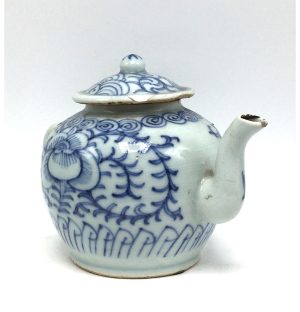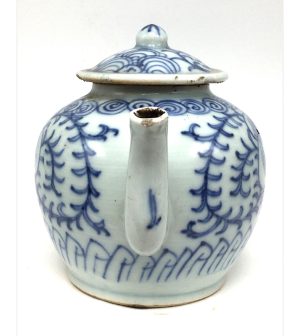-


$135.00
H: 5.25″ W: 4.625″ D: 2.375″ | FREE SHIPPING WITHIN CONTINENTAL U.S.!
This charming miniature ewer or small pitcher was made during the Tongzhi Period and probably used in a restaurant or home kitchen as a dispenser for soy sauce, oils or other liquids. With an elegantly curved spout and handle it is covered with chrysanthemums, plantain curved vertical leaves and bindweed vines. The lid has a lotus shaped bud for lifting, and the bottom has a Chinese antique export seal.
-
Sale!


$175.00 Original price was: $175.00.$115.00Current price is: $115.00.
H: 5.25” W: 4.75” D: 2.375” | FREE SHIPPING IN CONTINENTAL US!
This elegantly shaped small teapot has finely painted cobalt blue chrysanthemum and bindweed designs in the center and upper registers and plantain leaf designs at the bottom, popular underglaze design elements were widely used in late 19th century in domestic and export wares. Below the short neck is a chain of roundels with nineteen spirals, and the lid is covered with bindweed and wave designs, the latter indicating a sea or lake. The lid is topped by a ball handle topped with a four-line star and the bottom has an abstract plantain leaf design. It is in very good condition with two small chips on the lid and a small chip on the end of the spout. The inside has been stained by more than a century of tea brewing.
-


$115.00
SOLD
This finely hand-painted rectangular porcelain cobalt blue and white box with underglaze designs was used to store ink cakes as part of an assortment of prized items on a Chinese scholar’s desk. The cover is painted with bindweed designs, wave-like curved lines usually indicating water, and a fanciful bat’s face inside a continuous geometric meander or fret pattern. The box sides are covered with bindweed, spirals, and circles, and although circles and round shapes are usually associated with or represent heaven, these seem strictly decorative. There are traces of red, brown, and black ink inside and on the edges of the unglazed portions and rough and stained areas on the unglazed portions of the box and wear consistent with and demonstrating its age and use.
End of content
End of content






